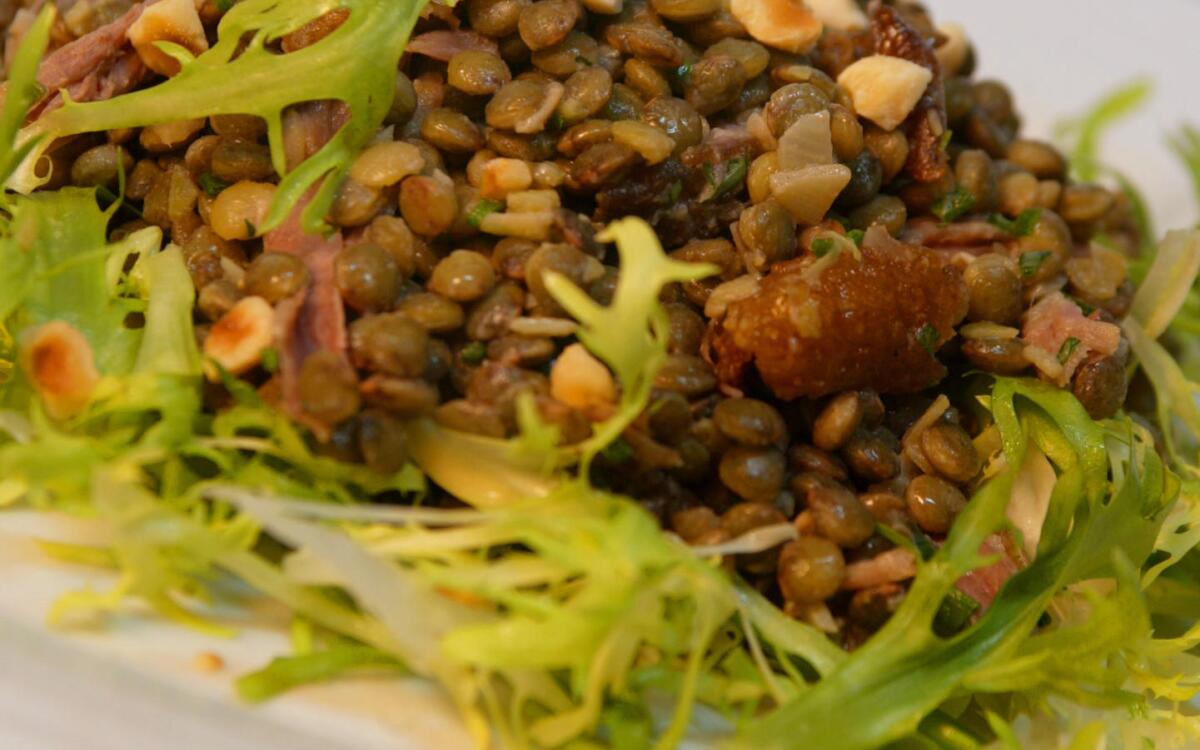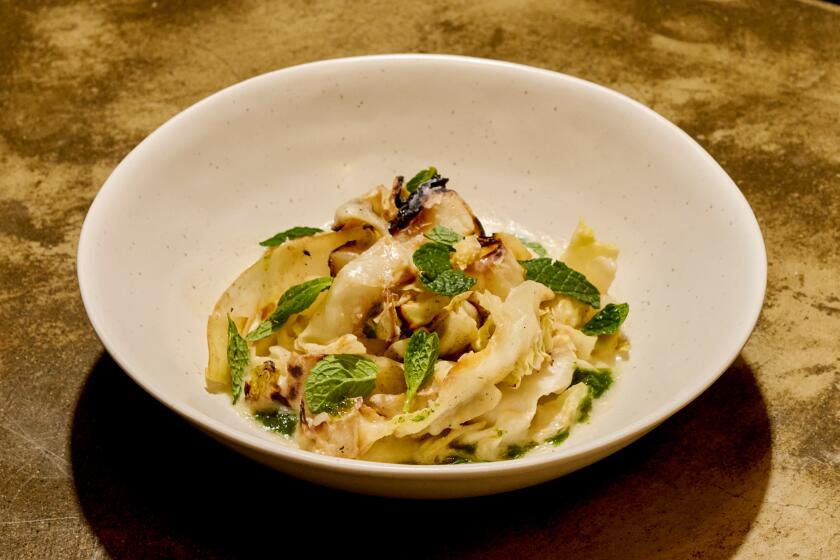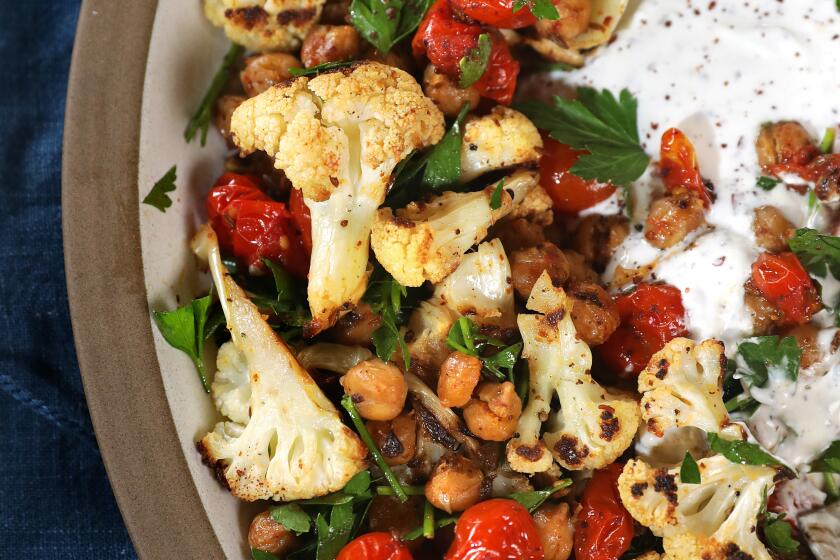Lentil and duck salad with hazelnut dressing

- Share via
One of the best things about food is a syndrome I call Cone Contagion: You see someone eating an ice cream and you have to have one yourself. But I never associated it with anything nourishing until a friend happened to e-mail that he was making lentil soup one January night.
Lentils suddenly sounded liked the best idea cooking. No other dried beans are ready so fast with so little effort, and none taste as meaty even with no bacon added. They’re the right food for right now.
But while my friend was eating for comfort, I went looking for excitement. Lentils have become quite an upscale ingredient, with enough cachet to be routinely showcased in high-end restaurants, particularly of the French persuasion. And while they may not come in 31 flavors, there’s enough variety lately -- both from Europe and from the United States -- that a good cook no longer has to settle for those mushy, muddy specimens sold bagged in supermarkets.
Soup is almost not good enough for these wondrous new lentils. They have such distinctive texture and flavor that they can be used in more refined dishes: in a warm winter salad, simmered in a stew with spicy sausage, or arrayed alongside a slab of fish or a duck leg or a pork chop.
When I was hit with lentil cravings, my stock was depleted of all but the black, red and yellow ones I had rounded up when I was going through my Indian-food obsession a year ago. But those are almost a separate animal from what I was able to buy in a couple of swings through specialty markets. The three most widely distributed Western kinds are shiny black beluga lentils, dusky iron-green French lentils and light tan Italian lentils from Castelluccio or Colfiorito, in Umbria. (Somewhere out in cyberspace I could have found Spanish pardina lentils, but Penelope Casas’ forthcoming book says those need overnight soaking, which takes away at least half their allure if you need a fast lentil fix. As does paying far more for shipping than for product.)
Every one of these varieties will cook up tender but firm in less time than it takes to roast a chicken. They need no overnight soaking, or even any parboiling. And unlike almost all other beans, they taste rich and soulful all by themselves. Pancetta or chorizo or a ham hock can only take them into another flavor dimension.
Belugas are the relatively new lentils on the block, with most of them grown in the United States. As their name indicates, they are tiny, perfectly round and deep ebony, with a nice gleam to their skin. Even better, they look as good cooked as they do fresh out of the bag.
These are great in a soup or salad or just as a side dish with smoky bacon. But I thought they were most outstanding paired with a clean-tasting white fish, such as petrale sole, with rosemary cream. The flavor combination was inspired by a recipe in Fredy Girardet’s “Girardet,” and the lentils stand up amazingly well to the pungent herb. Their own delicately earthy flavor also plays off the richness of the sauce.
French green lentils have been widely available for far longer than belugas; the Puy variety actually holds an Appellation d’Origine Controlee, which certifies their origin and quality. The ones grown in the United States and Canada are even easier to find. In every case they are very nutty-tasting, like all lentils, but their color and texture set them apart.
These are my favorites for salads, especially warm salads, with duck -- confit or smoked -- or smoked salmon mixed in. Cheese also goes well with them, particularly goat cheese, which is now almost a cliche, but also ricotta salata, which has similar tang but a more crumbly texture. They take well to vinaigrettes made with nut oils and accented with chopped toasted nuts.
Lentils from Umbria are just as seductive. They resemble the French kind in shape only: The flavor seems earthier to me, and they take slightly longer to cook. In Italy they are eaten for good luck at New Year’s, traditionally with a stuffed pig’s foot called zampone. But I like how well they adapt to Mexican seasonings and chorizo in a tomatoey stew.
All lentils have assertive inherent flavor, so much so that I could eat a potful with nothing more than salt and pepper. But they are always enhanced with aromatics -- onions, leeks, shallots, celery and carrots, and basic herbs, including bay leaves, parsley and thyme. Traditionally they are cooked with an onion studded with whole cloves, which not only add extra flavor but also hold the onion together as it cooks. Adding a branch of fresh thyme or sage as they simmer takes them up another notch.
Once they’re cooked, lentils can be combined with just about any fresh herb, whether dill or parsley or cilantro. I even like them with tarragon, my least favorite herb; there’s something about the anise quality that brings out another layer of flavor in lentils.
One great trick I learned from cooking lentils Indian style is called tempering: After the legumes have been simmered with turmeric, you add a sliced onion, cloves, stick cinnamon and chopped jalapenos that have been sauteed quickly in ghee or clarified butter. The second set of seasonings gives a real jolt of flavor.
The most essential trick to cooking lentils is using water sparingly. If they simmer in too much liquid, all the earthy flavor leaches out. You need to add just enough water to keep them bubbling gently until they turn tender but not mushy -- this is one legume meant to be eaten al dente.
As Harold McGee’s indispensable “On Food and Cooking” points out, lentils cook fast because they are flat and thin (the word “lens” comes from the name) and have thin seed coats, so water does not have to permeate as far as it does in other dried legumes.
A good rule of thumb is to add water to about 2 inches above the level of the beans and aromatics. You can always add a little more if needed to keep them from drying out.
I also find salting them makes them turn tender faster, while stirring frequently helps them cook evenly. Always, though, the cooking time depends on how old the lentils are. The more geriatric, the longer they take.
The one drawback to top-shelf lentils is the price. Italian lentils set me back $5 a pound, while the supermarket bags are less than a fifth of that.
But then those poor relations are really best for comfort and soup. As in so many things in life, excitement costs a little more.
Pick over the lentils to remove any stones. Rinse well in a fine sieve under cold running water. Place in a medium saucepan. Add the leek, garlic, bay leaves and 1 teaspoon salt.
Cut the carrot in half crosswise, then lengthwise and add to the pot. Add cold water to cover by 2 inches.
Bring to a boil, stirring often. Reduce the heat to very low and simmer, stirring occasionally, until the lentils are just tender but still firm, 17 to 20 minutes. Do not overcook. Remove from heat and drain well.
While the lentils cook, heat the oven to 500 degrees. Whisk together the mustard and vinegar in a small bowl. Whisk in the hazelnut oil until emulsified.
Discard the bay leaves, garlic and carrot from the cooked lentils. Combine the lentils and all but 1 tablespoon of the vinaigrette in a shallow bowl, mixing well. Set aside in a warm spot.
Lay the duck legs on a foil-lined broiler pan. Cook them under the broiler 6 inches from the heat source, turning once, until the skin is well crisped and the meat is warmed through, about 10 to 15 minutes. Using a fork and knife, shred or chop the meat and skin into rough pieces, trimming excess fat.
Add the meat to the lentils and mix well. Add the chives and tarragon and salt and pepper to taste.
To serve, toss the frisee with the remaining 1 tablespoon vinaigrette and distribute it among 4 salad plates. Top with the lentil mixture. Sprinkle with hazelnuts.
Get our Cooking newsletter.
Your roundup of inspiring recipes and kitchen tricks.
You may occasionally receive promotional content from the Los Angeles Times.













